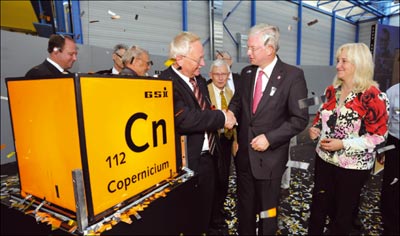
On 12 July, a ceremony at GSI celebrated the entry of copernicium into the periodic table of elements with a symbolic christening for the new element. Copernicium is 277 times heavier than hydrogen and the heaviest element officially recognized in the periodic table. It is named in honour of the astronomer Nicolaus Copernicus.
Element 112 was discovered at GSI in 1996 by an international team of scientists led by Sigurd Hofmann. The element has officially carried the name copernicium and the symbol Cn since 19 February 2010. Naming the element after Copernicus follows the long-standing tradition of choosing an accomplished scientist as eponym.
The team of scientists at GSI, from Germany, Finland, Russia and Slovakia, produced the new element for the first time in February 1996, by firing zinc ions onto a lead foil. The fusion of the nuclei of the two elements produced one atom of element 112. Although it is stable for only a fraction of a second, the team identified the new element through the radiation emitted during its decay. Further independent experiments at other research facilities confirmed the discovery of element 112 and in 2009 the International Union of Pure and Applied Chemistry officially recognized the existence of element 112 and acknowledged the GSI team’s discovery by inviting them to propose a name.





